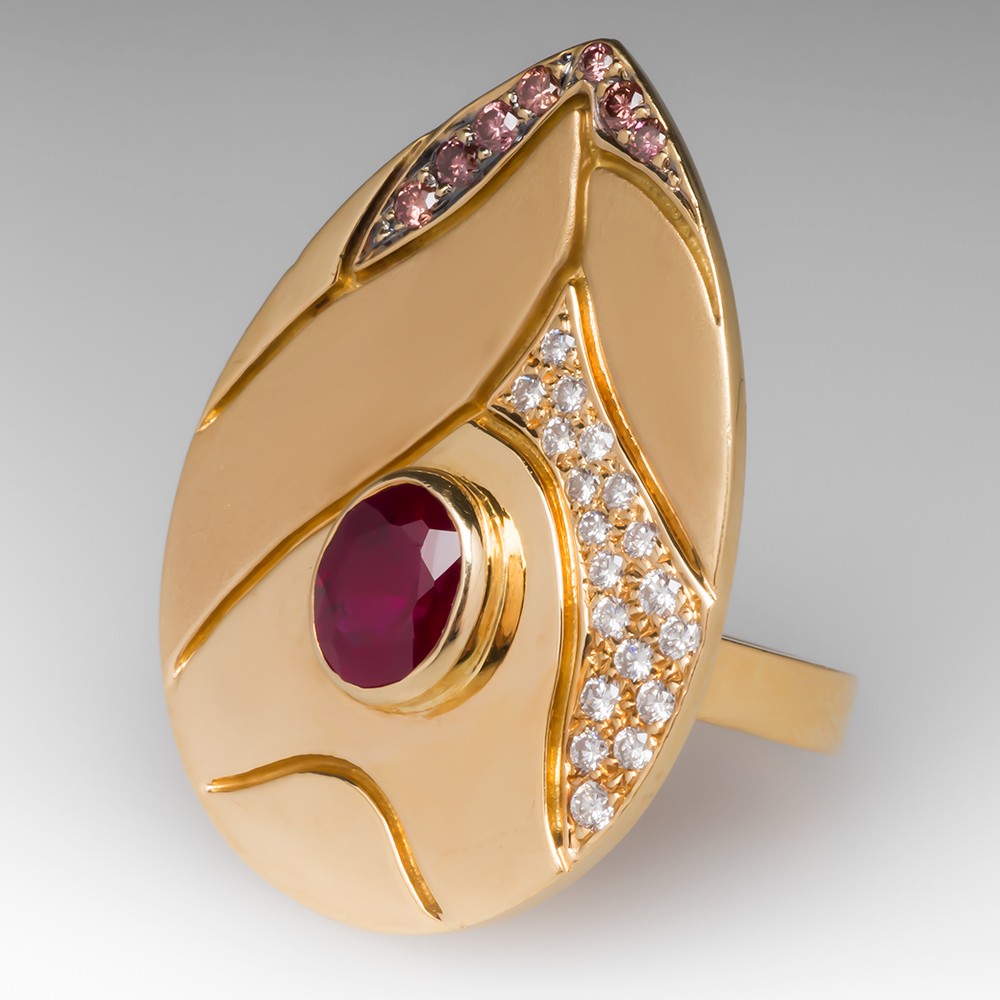Posted in: All Things Jewelry, Jewelry History
 This gorgeous Tenthio cocktail ring features a striking oval-cut lab-created ruby. It also features natural and synthetic diamond accent stones. Photo ©2018 EraGem Jewelry.
This designer cocktail ring, featuring a gorgeous lab-created ruby, resembles a budding flower. Golden petals trimmed in natural and lab-created diamonds nestle against each other to form a tight bud. Embedded in their midst is a 1.3 carat created ruby.
This gorgeous Tenthio cocktail ring features a striking oval-cut lab-created ruby. It also features natural and synthetic diamond accent stones. Photo ©2018 EraGem Jewelry.
This designer cocktail ring, featuring a gorgeous lab-created ruby, resembles a budding flower. Golden petals trimmed in natural and lab-created diamonds nestle against each other to form a tight bud. Embedded in their midst is a 1.3 carat created ruby.
Synthetic vs. Lab-Created Ruby
Synthetic rubies are chemically discrete from natural rubies. They are most often made out of glass, but can also be made from resin, plastic, ceramic, or other materials. Rarely will you see an imitation ruby at a fine jewelry store, unless it is incorporated as an original part of an antique. A reputable jeweler labels all imitation rubies as such, using terms like imitation, synthetic, or glass. A lab-created ruby, on the other hand, is chemically identical to a natural ruby mined from the earth. It has the same chemical, optical, and physical properties of a natural ruby. As long as they are properly labeled, lab-crated rubies are definitely a purchase worth considering. As their name implies, created rubies grow in a laboratory setting. Today, gemstone chemists continue to use the historical flame fusion process discovered in the late 1800s by Auguste-Victor-Louis Verneuil.History of the Lab-Created Ruby
Scientists first attempted to create rubies in the early 1800s. Rubies proved rare, and when found they rarely exceeded 3 carats in size. Industry demanded a greater supply, particularly as microabrasives and for jeweled watch bearings. The French chemist, Edmond Fremy, reached success first with his huge fireclay crucibles. A mixture of alum, red lead, silica, and potassium dichromate reached temperatures referred to as "red heat" in these crucibles. When held at this high temperature for 20 days, the result yielded small, brittle, but perfectly formed rubies identical to naturally mined rubies. Verneuil, who began as Fremy's lab assistant, carried on with the crucible experiments, eventually forming created rubies the size of a nail head. While one jeweler successfully mounted a few of these created rubies into a brooch, and others used them in watches, their small size rendered their use limited in the jewelry industry. Eventually, Verneuil discovered Geneva rubies. In 1885, an influx of large jewel-grade rubies hit the market. These rubies appeared to be high-quality stones of rare large carat size. They sold for thousands of dollars per carat. However, under microscopic scrutiny, these rubies contained minute opaque spheres, gas bubbles which formed during some sort of melting or fusion process. The French Syndicate for Diamonds and Precious Stones declared them "artificial." They forbid jewelers from selling them as natural and forced those who had already sold them to refund their customers' money. The source of these Geneva rubies remains a mystery to this day.Flame Fusion
While the Geneva rubies caused a fuss for many jewelers, Verneuil studied these manufactured gemstones, looking for a new approach to creating rubies. Using a hydrogen-oxygen or gas-oxygen mixture, Verneuil began using blowtorches to apply flame heat directly to a ruby "feed" made from aluminum oxide. Over the next 15 years, Verneuil continued to perfect his technique, creating several means for controlling flow of the feed and gas mixtures, as well as timing for removing the heat. Finally, in 1902, he published his perfected flame fusion method for creating rubies. This method remains the favored method for creating rubies, as I mentioned before. In two hours, a lab assistant created a 15-carat boule which could be cut into several faceted rubies. A flame fusion-created ruby possessed identical chemical and optical properties as a natural ruby. The only differences were physical, visible only at the microscopic level. Indeed, they were almost too perfect, lacking the usual inclusions of their natural cousins.Benefits of Lab-Created Rubies
Lab-created rubies offer the jewelry connoisseur several benefits. For one, they come at a lower price point than natural rubies. Yet, they radiate with gorgeous color and beautiful shine in the same way as natural rubies. As such, lab-created rubies are the perfect choice for traveling. Travelers often leave their authentic jewels at home, locked away in their safe, while out of the country. But perhaps you wish to travel in style. In that case, we urge you to travel with your lab-created ruby jewelry. That way, you can shimmer and shine as usual without as much fear of loss. Finally, creating rubies in a lab leaves a smaller carbon footprint. Manufacturing rubies in a lab uses far less natural and manmade resources than mining rubies does. Here at EraGem, we have a handful of lab-created ruby (and other sapphire) jewels we would love to show you. We welcome your call and look forward to hosting you in our showroom very soon.6 years ago
6 view(s) 